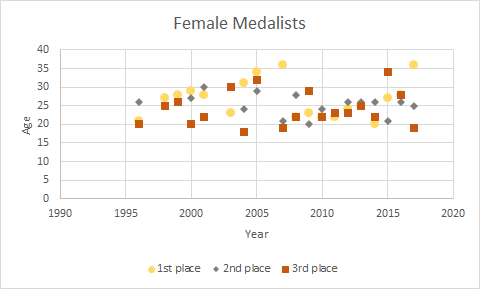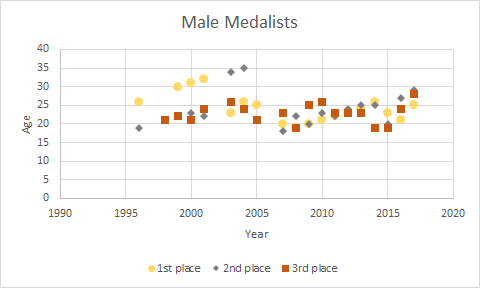The Pathway to Trampolining Success
By Ryan Hatfield
Abstract
The intention of this paper is to investigate the pathways of competitors at the highest end of trampoline gymnastics: Olympic and World Championship medallists. This paper is from a sports science perspective, looking at the international landscape of athletes. Data came from World Championship and Olympic results between 1996 and 2018. Three years (1997, 2002, 2006) were excluded due to not having a World Championships or Olympic Games, leaving 20 years of competition to analyse. The findings found that most World Championship / Olympic medallists began trampolining between the age of 10 and 15, with some sporting background, they entered elite level competition within 2-7 years of starting the sport and became a World Championship / Olympic medallist in their early to mid-twenties.
Introduction
Little is reported on the pathways of elite trampoline athletes. There is a common knowledge in the trampoline community to use research based on artistic gymnastics and extrapolate that research to develop trampoline pathways that fit the artistic gymnastics model. There is no evidence to support this idea.
Artistic Gymnastics is known to be an early specialisation sport (Strachan, 2009), where many athletes specialise in their sport before the onset of puberty. For most other sports, research finds that participating in multiple sports is important, before specialising later. Specialisation during late adolescence enhances senior sporting success and minimises the chances of overuse injuries (Jayanthi, 2013). Establishing where trampolining fits on this spectrum will critically affect how pathways are developed and viewed.
Depending on the early pathways of elite trampolinists, further research can be done into how these pathways can be systemised and implemented to accommodate future success of trampolining in Australia.
Methods
Successful athletes, in this paper, are defined as medallists from World Championship and Olympic Games. Results from every World Championship and Olympic Games event between 1996 and 2018 were observed, and the top three placings from each final were recorded. Three years (1997, 2002, 2006) were excluded due to not having a World Championships or Olympic Games, leaving 20 years of competition to analyse.
Athlete identification was recorded, then research was conducted by looking into biographies, interviews, and as many points of reference to the athlete as obtainable. Where known, birth year, and details on age when entering the sport, age of specialisation, age of first international competitions, medals and similar details where recorded. Information was not available for all athletes.
Results
Age of Successful athletes
Age data were gathered for all 60 female medallists and 58 out of 60 male medallists. The average age of a successful female athlete is 25 years old and the average age of a successful male athlete is 24 years old.
Most successful athletes are achieving success in their twenties. However, some athletes continue their success into their thirties, with 9 medals won by 4 different women in their thirties and 5 medals won the same man in his thirties. Some athletes also win medals aged 19 or younger, with 3 medals won by 3 different women in their teens and 6 medals won by 5 different men in their teens.


Age started the sport
This information is less reliable, as it was gathered through biographies and interviews and is difficult to verify. Of both the women and the men, most started trampolining between the age of 10 and 15 years old, and had some sort of sporting background, most commonly diving, tumbling or artistic gymnastics. Generally, those who started trampolining earlier than 10, did not have as much previous sporting experience. There are a small number of examples of successful trampolinists who started before the age of 10 or after the age of 15, with some starting as young as 5 or as old as 20 and going on to win World Championship and Olympic medals.
Discussion
Peaking
The average age of successful female trampolinists is 25 and the average age of successful male trampolinists is 24. Athletes who achieve success younger than this, have gone on to improve their results by the time they reach this age, and many hold on to their success into their late twenties and sometimes thirties. It is rarer, but some athletes will win their first medal when they are older than this. Average of successful athletes appears to be a reasonable predictor for the age an athlete should reach their peak. However, the amount of change that trampolining has seen over the timeframe of this research, may skew peak age data to make it appear lower.
The sport of trampolining has had significant changes, such as new rules and advancements in technology, over the past 20 years. These changes favour younger athletes. As each generation changes, they also adapt. For example, an athlete may win a medal at age 21 and make incremental improvements year after year until they are 28. Another athlete, 5 years younger, may beat the 28-year-old at age 23, because they have adapted better to the new rules or technology. This athlete may also go on to make incremental improvements into their late twenties only to be beaten by the next generation and so on. If the rate of change of the sport slows down, the average age of successful athletes may increase, as athletes continue to improve their skills instead of trying to adapt to changes in rules or technology. In other sports, the most successful athletes are in their mid to late twenties, and it has barely changed for decades (Schulz, 1998; Berthelot, 2012). FIG has pledged to decrease the amount of change in trampolining equipment, and we may find a more stable environment in trampolining with fewer changes to rules and technology. This may result in the peak age of athletes increasing.
Young Success Stories
Three medals have been won in the women's event and six in the men's event by athletes younger than twenty. It should be noted that all females who won a medal in their teens came third and only one male became a world champion in their teens. All athletes who won a medal as a teenager, achieved additional medals into their twenties, usually improving their results, with all except for three winning a gold medal. This data confirms that while young medallists exist, even they do not reach their peak until they are in their twenties. Most of them have continued to win medals into their late twenties.
How successful athletes go from starting to successful
Australian research into Olympic sports found that 28% of athletes reach elite status within 4 years of starting and 69% of athletes reached elite status after 7.5 years. From the present research, most athletes are starting the sport between 10 and 15 and becoming successful in 10-12 years. Most athletes competed in some sort of international competition after 2-7 years of involvement in the sport. However, there is a lot of variability between athletes. There is little information regarding specialisation available for trampoline athletes, but it is safe to assume that most athletes were not specialised trampolinists from the moment they started the sport.
Australian research shows that participating in multiple sports is important, before specialising in a sport and playing year-round at around 13-15 years old. The research also finds that athletes who start at young ages are unlikely to stick around; children who begun participation in organised sport at 7-9 years old are more likely to continue than kids who started at 4 or 5 years old.
Conclusion
It takes most Olympic athletes 4 - 7.5 years to reach elite level, and most trampolinists are starting between the age of 10 and 15 and reaching elite level in their late teens. Trampolinists are reaching their peak success in their mid-twenties, winning medals at World Championship and Olympic events usually less than a decade after starting the sport. There is a lot of variability between athletes, showing that there is no single path to success.
A Pathway model for trampolining
Based on the findings of this research, the following may be an age based generalised guideline for a high-performance pathway model in the sport of trampolining
Age under 7 - Be involved in play and movement
- Starting trampolining at this age may hinder success, as the athlete is not likely to compete in their twenties. There are only 3 verified examples of successful athletes who started trampolining under the age of 7
Age 7-9 - learn fundamental movement patterns
- Starting trampolining at this age won't make a meaningful difference to success as a senior athlete, if athletes start at this age, they should focus on fundamental movement patterns and body, learning the same skills that they would learn in any other organised physical activity
Age 10-15 - start trampolining with lots of free-play and focus on fun
- Begin involvement in trampolining, learning the skills and rules of the sport.
- Entering competitions will be advantageous to learning the rules and layout of competition
- The main goal is to keep the kids enjoying the sport enough that they want to continue into their mid-twenties. Reducing drop out is more important than specialisation or competition success (threats, negative pressure, and any other stressors that encourage drop out should be avoided)
- Start increasing hours of training and decreasing involvement in other sports (specialisation) after several years of training, but preferably not before age 13-15
Age 16-21 - keep it fun, start to recruit elite development teams
- Athletes who enter the sport at this age can still be successful but may have to specialise soon after beginning training
- The main goal of this age group is to have athletes who are beginning to specialise and set goals for their twenties
- Specialisation and more rigorous training may become appropriate to develop fitness and skill ability becoming prepared for the predicted rules and climate of competition in 5 years' time
- These athletes begin to enter in senior international competitions with the goal of increasing their experience and preparing them for success in future competitions, not with the goals of success at the present competitions
- These athletes should be focused on increasing their physical capacity (strength) and they need to be taught skills in their sport, psychological skills, skills to help them with sponsorship and financing their competitive career, and skills to manage their balance between their training and personal life.
- Athletes should not have to choose between sport and school or other temporary endeavours. Some athletes have been known to quit temporarily (6 months to 4 years) and return to become Olympic and World Champions, so reducing workload from time to time will not ruin their future
Age 20-30 - reach and hold peak performance
- Athletes at this age are going to have to make compromises to become successful.
- These athletes are at their peak and should have World Championship and Olympic medals as their primary goal
- These athletes need support to enable year after year success, juggling their finances, training, personal life and having a career prepared for when they retire.
References
Strachan, L., Côté, J. and Deakin, J., 2009. "Specializers" versus "samplers" in youth sport: comparing experiences and outcomes. The sport psychologist, 23(1), pp.77-92.
Jayanthi, N., Pinkham, C., Dugas, L., Patrick, B. and LaBella, C., 2013. Sports specialization in young athletes: evidence-based recommendations. Sports health, 5(3), pp.251-257.
Schulz, R. and Curnow, C., 1988. Peak performance and age among superathletes: track and field, swimming, baseball, tennis, and golf. Journal of Gerontology, 43(5), pp.P113-P120.
Berthelot, G., Len, S., Hellard, P., Tafflet, M., Guillaume, M., Vollmer, J.C., Gager, B., Quinquis, L., Marc, A. and Toussaint, J.F., 2012. Exponential growth combined with exponential decline explains lifetime performance evolution in individual and human species. Age, 34(4), pp.1001-1009.
More:
